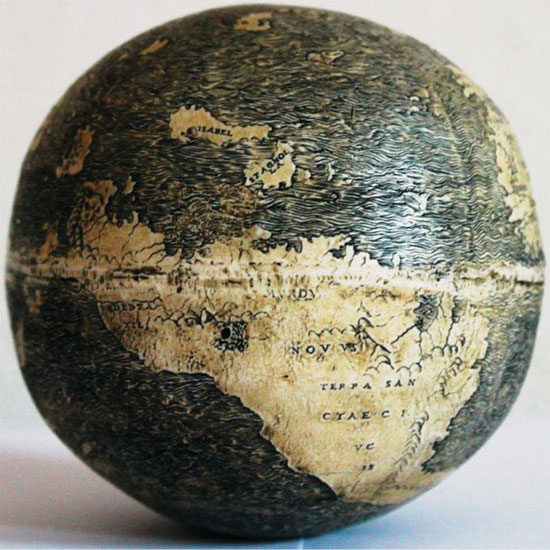The oldest globe to paint the New World?
An Austrian collector found the basis for making it the oldest, 1504-year-old earth, with the New World, engraved with sharp details on the two halves of ostrich eggs, according to Washington Post.
The globe, as big as a grapefruit, is noted in Latin and contains territories that are considered mysterious like Japan, Brazil and Arabia. North America is drawn as a group of discrete islands. On the coast of Southeast Asia, there is a blank sentence written on the ball: 'Hic Sunt Dracones'. 'These are dragons', a very interesting sentence , ' said Thomas Sander, editor of Portolan, Washington Map Society journal, comment. This magazine published a full analysis of the globe on August 19 by Stefaan Missinne. In the old maps, you can see the images of sea monsters, which is a way to express bad things there.
Another map or globe on which this particular sentence appeared made us think that it was the twin brother of the egg: the Hunt-Lenox bronze sphere , dated about 1510 and is being kept by the ministry. Quarter of the New York Public Library. Before the egg, the bronze ball is considered the oldest sphere of the New World. Both have special similarities.
After comparing the two spheres, Missinne concluded that the Hunt-Lenox ball was a model cast from an carved ostrich egg. Many detailed details, such as lines and lines of territories, oceans, eggs of the eggs that match those on the Hunt-Lenox sphere have been carefully studied.
The egg shape is slightly irregular, while the bronze sphere is a perfect sphere. The markings on the equator of the egg, where the two halves of the egg are assembled seem a bit tangled.
Missinne argued that the egg shrunk and distorted over time, and he confirmed that there was a decrease in density when using sweeping waves to calculate. He also suggested that both halves of the egg were individually modeled, and then assembled with a glue that blurred the carvings around the equator.

This is North America, only two islands are as small as an endless ocean.(Photo: Washington Map Society)
The egg, still unknown to the owner, was offered by a trader at the London Map Fair in 2012. He said it was part of an important European collection for decades, according to Missinne. Accordingly, Missinne - a Belgian real estate project developer, consulted more than 100 scholars and experts to write a study analyzing the globe that took a whole year.
'He spent five years of research to focus on a year of analysis,' said Sander, who called Missinne's journey a 'unbelievable discovery story'.
Missinne, 53, developed a passion for studying distant objects and incense for 20 years, when he bought an early ancient map - an 18th-century bronze map carved in northern Germany - without Know its origin and start investigating.'From the prints and the map, you advance to the ball, then from the spheres to the other crafts including furnishings like ostrich eggs' , he said.
Missinne guessed that the egg could have loose ties with Leonardo da Vinci's studio, based on the inscription of a ship in the Indian Ocean similar to the one a artist had dearly carved with Leonardo.
The egg has no name engraved on it, so the manipulator doesn't know who. But Sander thought that someone from the time of da Vinci came from knowledge reinforced by fellow astronauts, and had crafted a sphere for an Italian noble family.
'At that time, ostriches were great animals for aristocrats to rear it in the garden,' Sander said.
The ball moved from house to house and after World War 2, like many other fine arts, it was sold at times of economic hardship, Sander and Missinne agreed.
'Where does this thing come from?' , Chet Van Duzer is from the John Carter Brown Library in Providence, Rhode Island, a Renaissance cartographer. 'It was a dramatic discovery, of course, but I think more tests are needed'.
John W. Hessler, Library of Congress, said he saw 'a couple of important signs emerging' while reading Missinne's research. He had heard from some sources that Missinne was the anonymous owner of the sphere, causing a conflict of interest, and Missinne was valuing the importance of her discovery.
Missinne declined to comment on how he owned the ball.
(New World: Christoph Columbus first landed in the Bahamas of the New World in 1492, which he thought was Japan).
- The first water in the world can be eaten
- 14 oldest ancient artifacts in the world
- The oldest man in the world died, aged 112 years
- 10 oldest antiquities in the world
- 7 unique methods of cooling the Earth
- Paint smart
- The oldest eel in the world died
- The oldest man in the world has yet to feel old
- New invention: special reflective paint for cyclists in the night
- The world's oldest man welcomes his 112th birthday
- The 114-year-old woman is the oldest woman in the world
- Nano paint helps stealth aircraft
 Discovered an ancient centipede fossil 99 million years old
Discovered an ancient centipede fossil 99 million years old Discovered bat-like dinosaurs in China
Discovered bat-like dinosaurs in China Discovered a 200-year-old bronze cannon of the coast
Discovered a 200-year-old bronze cannon of the coast Discover 305 million-year-old spider fossils
Discover 305 million-year-old spider fossils